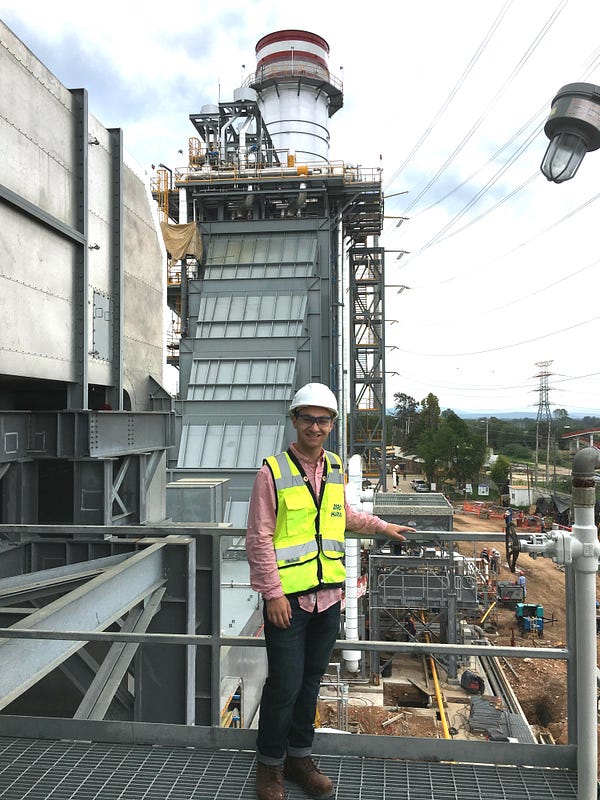Greg Robinov: Getting Ready to “Flip the Switch” on a Power Plant in Mexico
Greg Robinov, a junior majoring in Mechanical Engineering and Applied Mechanics (MEAM), loves to be involved on campus. As both a MEAM mentor and a board member of the American Society of Mechanical Engineers, Robinov enjoys serving the engineering community and lending a hand to underclassmen. Outside of the classroom, he writes for the sports section of the Daily Pennsylvanian, cheering on the Quakers, and is also active in the brotherhood of Phi Kappa Psi. Looking ahead, Robinov plans to utilize his technical and analytical education to move into an engineering management role within the energy sector.

I knew it like the back of my hand. Through the drawings, pictures, diagrams, and even 3D models, I had seen every inch of the place. From the four-story air inlet housing down to the flashback thermocouples on the combustion baskets, I had combed over every detail. But when I first stepped my steel-toed boots down onto the muddy grounds of the Francisco Pérez Rios Thermoelectric Plant, I was awestruck. The nearly 1,600-megawatt facility sprawled out across the landscape, exhaust stacks poking out periodically from the maze of pipes and enclosures of the five generating units.
This was a rainy Tuesday in Tula, Mexico, a relatively quiet city of about 100,000, merely an hour’s drive northeast from the sprawling metropolis of Mexico City. I was one of ten or so engineers that had flown in from across the globe for the first unit’s readiness review. The mechanical leads were German, the generator specialists were out of Charlotte, NC, and the project team, myself included, made the trip down from Orlando, Florida. With our hardhats and safety vests strapped on, we began to traverse the gargantuan facility with our checklists in hand.
As a project engineering intern in the large gas turbines division of Siemens Energy, I had a lot on my plate. In a nutshell, my group was responsible for the successful completion of the plant. In this case, we were working with the Mexican national utility, Comisión Federal de Electricidad, to modernize their machinery with new higher-efficiency gas turbines. Over the course of the previous ten weeks, I had worked feverishly to ensure parts and personnel were moving into place harmoniously.
Of course, I was only seeing a small sliver of the many years of designing, testing, and constructing that predated my arrival. But, nonetheless, I was feeling almost intimately connected with the project, likely due to the many hours I had spent looking at the turbines in design software, on the phone with manufacturers, or in meetings with the commissioning crews. And now, seeing as I had traded my climate-controlled office for trailers and portable toilets, things had escalated.
For the readiness review team, this commenced four days of inspecting every inch of the machinery, leaving no junction box unturned. Armed with a flashlight, camera, and pencil, I carefully traversed the gas turbine enclosure and its maze of pipes to scrutinize my areas of expertise. Careful comparison between the physical components and the pertinent drawings allowed us to verify the plant’s operational viability, piece by piece.
As the days rolled by, typically marked by unreasonably early mornings, irreparably dirtying one’s shirt, and a big, savory local lunch, we approached Friday’s culmination meeting. In one of the largest trailers on site, Siemens engineers took up one side of the “boardroom” table, with plant officials seated across from them. One by one, presentations were given for the various subsystems, with pause for discussion about deviations and solutions. After maybe three hours, both sides came together to shake hands and set a course for the momentous first-firing of the turbine.
Fortunately, I was able to tack on an extra day for sightseeing, including the incredible Teotihuacán pyramids and grand Zócalo plaza, before dragging my tired legs onto the plane. Reflecting on it all high above the Gulf, by far the most interesting part of the job was its multifaceted nature. Gaining exposure to some of the many entities within an engineering firm gave me some pause for thought. While at Penn, I had particularly gravitated towards the design side (thanks to MEAM’s Machine Design and Manufacturing class), but that work would be for naught without the trailblazing done by the R&D groups or governance provided by project management.
Engineering is first and foremost a collaborative endeavor. That’s a given, but moreover, I’ve learned how many aspects must be properly considered to achieve project success. Shrewdly balancing budgetary and performance needs, reliability demands with timeliness, is truly a Herculean task. While there is no replacement for core engineering capabilities in statics and thermodynamics, one won’t get very far without an affinity for the economic, legal, and even environmental considerations. Incidentally, I write this now on the trip home, reevaluating this semester’s schedule and adding another Engineering Entrepreneurship course. Admittedly, the seemingly limitless stock of metal in the machine shop sets up some unrealistic expectations about resource management in the real world. Going forward, I’ll try to be more conscious of the fuller scope of my course projects to better reflect those considerations in industry.
This internship has been an invaluable opportunity for me to broaden my personal and professional horizons. From a technical standpoint, my aptitude has increased tenfold for dynamics calculations, thermal simulations, and electrical diagramming. Simultaneously, I experienced an international corporate atmosphere, presented findings to experts and customers, and developed enough Spanish to successfully order street churros. I’m looking forward to taking all I’ve learned back to campus and hopefully continuing down the energy and sustainability path with new classes, research opportunities, and professional involvements.
